
Flat Mount Disc Brakes vs. Post Mount Disc Brakes
The Really Short Answer: As far as the 'brake' goes, there is NO difference. They are exactly the same. That being said, one will add about 500 hundred dollars to your custom build.
The difference, as the names imply, is simply the 'mount'. What's the difference then? Well, they both mount to the frame with 2 bolts, but the placement of the bolts is slightly different. One of them allows us to build the frame a bit lighter (although that is not true with most builders).
Since we build the Rodriguez Phinney Ridge (post mount brakes) and also the Rodriguez Bandito with flat mount brakes, we answer this question a lot.
If the short answer isn't good enough for you (it never is for me), then feel free to continue on to a graphic illustration and a little bit longer answer.
In case you haven't noticed, there's a whole lot of confusion in our industry about terms used to describe types of disc brakes. So much confusion in fact, that it's even created apprehension on the part of many 'would-be' bicycle buyers in making their decision on what type of bike they should buy. This is not an article proclaiming bias towards one or the other, but rather an educational article for those who are trying to navigate the ever changing jargon in the bicycle world. We make Rodriguez models with both styles of these brakes, and we like them both. As is always my goal, I'll de-mystify the terms for you and show you that there's no reason to be afraid...of either brake description. We always seek to look past the hype, and educate our customers on these subjects. You don't survive years in the bicycle industry without learning a thing or two, and we aim to share that knowledge with you. Off we go...you asked for it!
Just for fun: Check out the images below. One is a post mount and the other a flat mount SRAM Red hydraulic brake. See if you can tell which one is which:
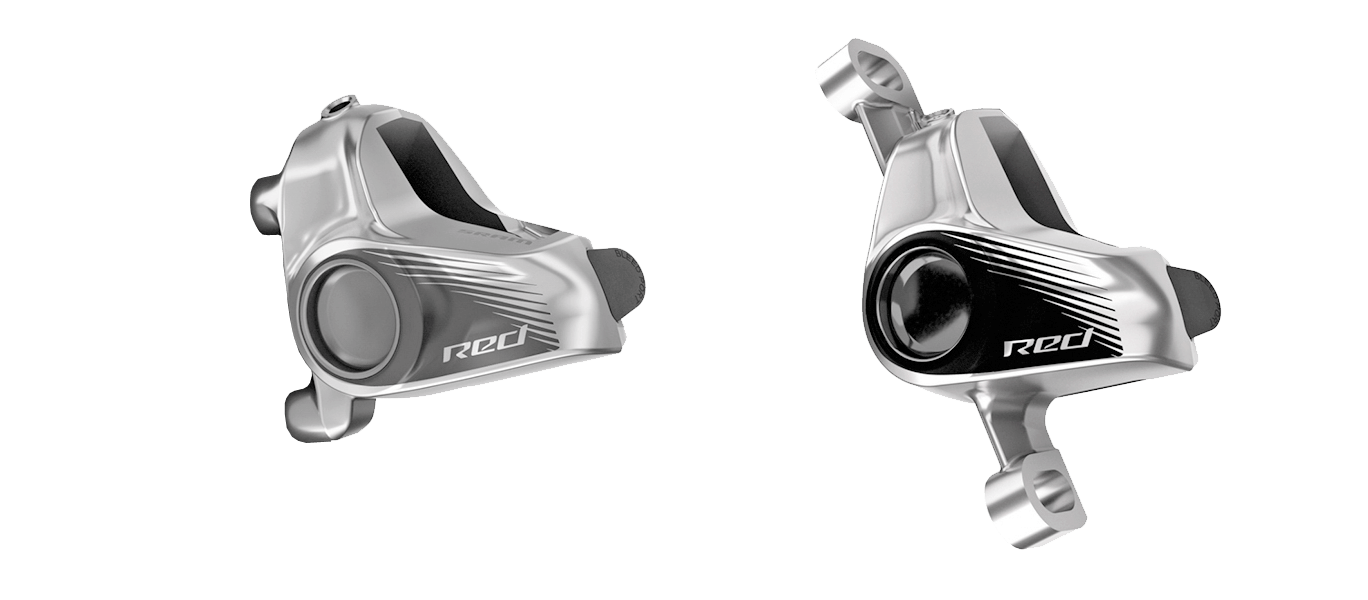
If you can't tell, I'll try to make it easier. The only difference is the location of the mounting bolts. Here's another image showing where the bolts attach to the brakes. See if this helps you determine which is which:
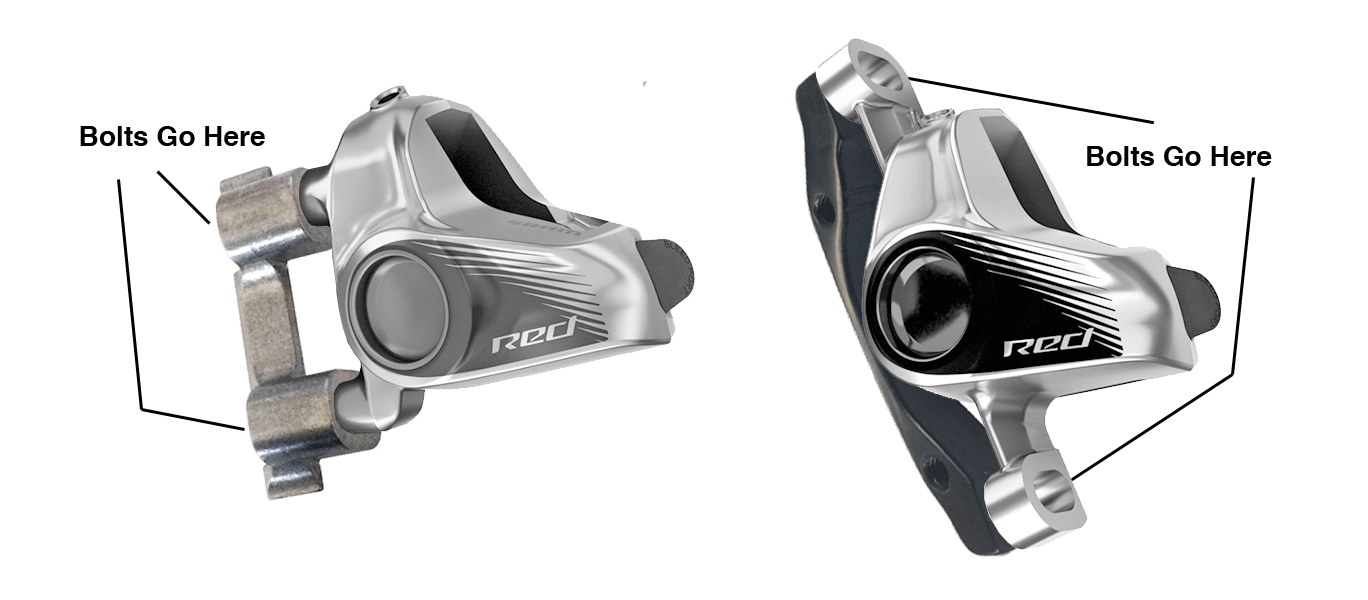
Now can you tell? If you cannot already, you may be able to by the end of this article. Or if you want to know now, here's the answer. For those of you still curious, read on.
So why are there 2 different kinds of mounts?
First, To the Wayback Machine: Bicycle disc brakes have been around since the 1970's, but only started working well in the last decade. We'll start about ten years back when bicycle disc brakes first started working well.....or at least working well to stop the bicycle. These brakes were called 'post mount' brakes, and a standard was adopted. They created other problems though. Problems that really had to be solved for road bike riders. The disc brake caliper had to be mounted to the bike in such a way as to make mounting fenders or a rear rack almost impossible. The rear brake for instance had to be placed right where these accessories had to go.
2009ish rear disc brake mount
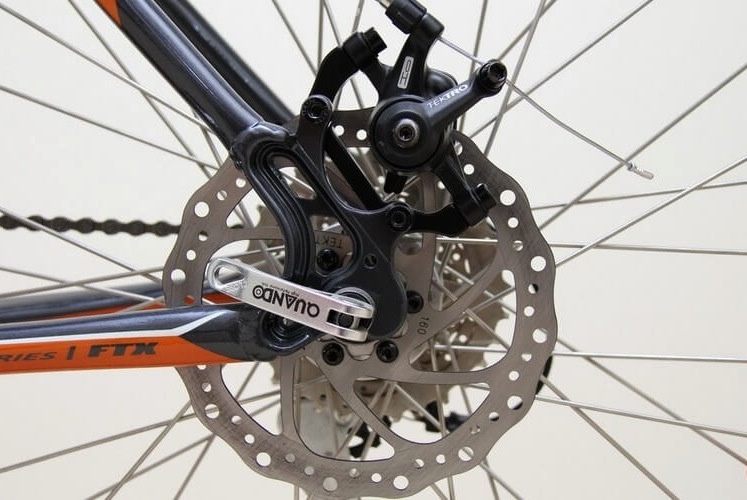

Posed a real problem for mounting racks and fenders
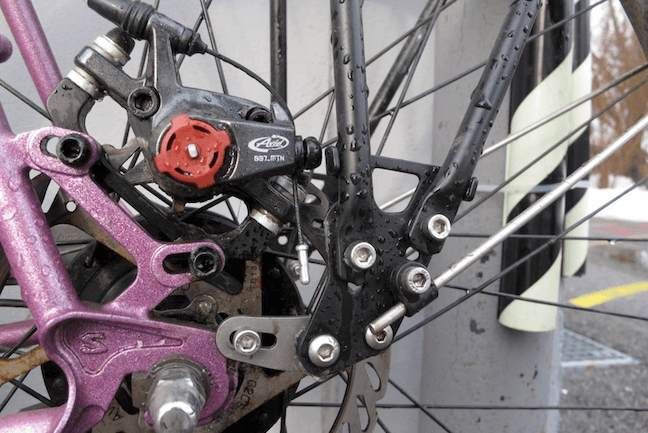

Custom Bicycle Makers to the Rescue
It wasn't long before custom bicycle manufacturers, like us, came up with elegant solutions to this problem. Those solutions were certainly beautiful, but also practical because they moved the brake caliper inside the frames rear triangle. This allowed for mounting fenders and racks just like a bike with standard rim brakes. Problem solved....right? Keep reading.
See the photos below to see how were here at Rodriguez solved this problem back in 2010 for our Phinney Ridge model.
Rodriguez Phinney Ridge rear disc brake
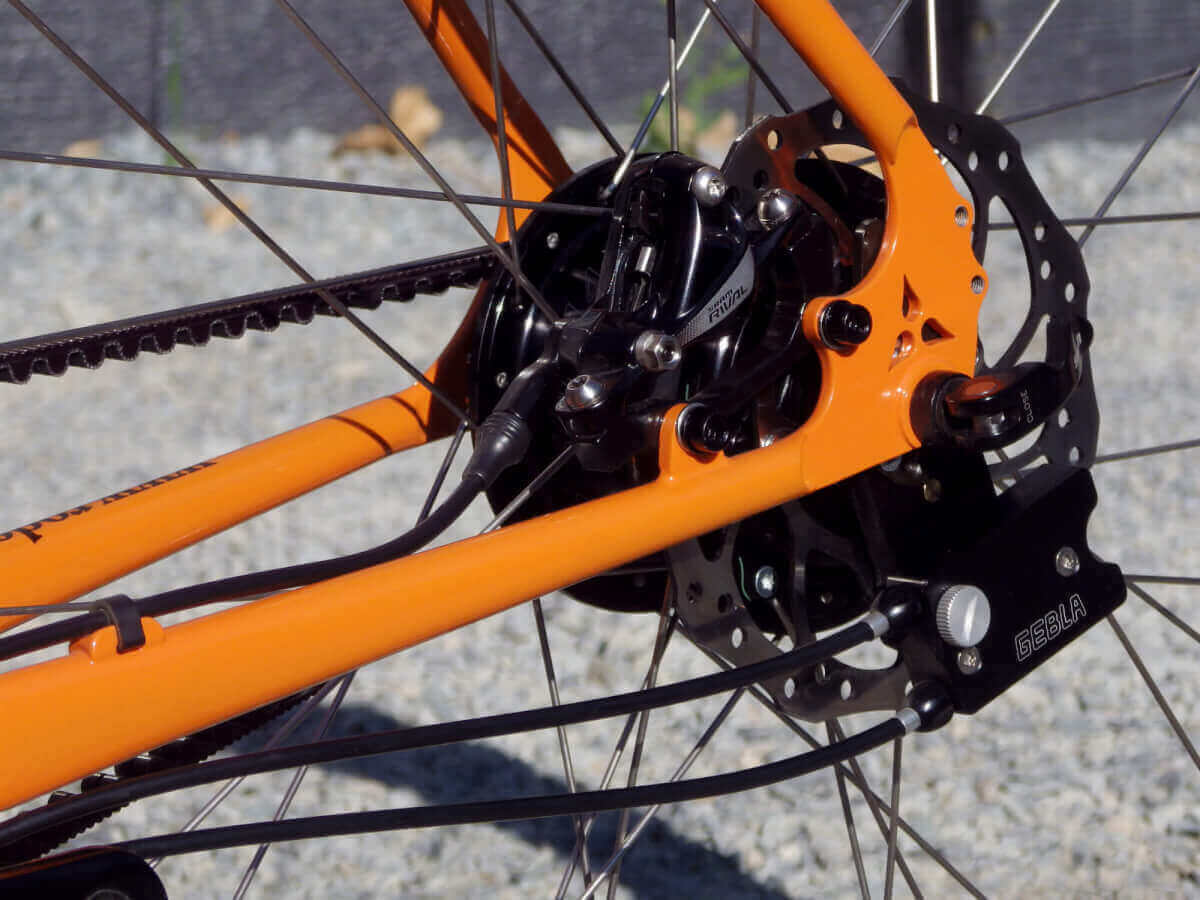

Beautiful design, plus racks and fenders No Problem!


Moving Forward in Time
Here's where 'flat mount' brakes come in. Although custom bicycle manufacturers solved the problem long ago, the industry as a whole was struggling to design special (hideous) rear racks or fender mounts to adapt to the original, inconvenient caliper placement. At the same time, some of the component manufacturers tried to come up with a different mounting system for the brake calipers to help solve the problem. The result was the new 'flat mount' design. As you've seen earlier, the brakes are 100% identical except the placement of the mounting bolts. The new 'flat mount' is supposed to be more compliant with mounting inside the the rear triangle of the frame (like we already do with post mount). That's it. That was the full reason for the new design.
The problem is, that it adds a lot of complexity to a custom build, and this adds cost. It's my opinion that if cost is added, then a benefit for the customer should also be added. Otherwise, it's simply wasted money.
At Rodriguez, we build bicycles with flat mount brakes, and also bicycles with post mount brakes. We like them both. Our Rodriguez Bandito, with flat mount brakes is more expensive than it's disc brake cousin, the Rodriguez Phinney Ridge, in large part because of the flat mount brakes. Not because of the brakes themselves, but because of our exclusive build method that we use to save 4oz. when using the flat mount brakes. I will write up another article at a later time detailing this method. But realize that most other brands do not use our weight saving method, and may even be adding weight over a traditional build when they use 'flat mount' brakes.
In short, every disc brake bike that we build gets the benefit of having the caliper cleanly mounted inside the frame, and out of the way of accessory mounting. The customer gets the same convenience and braking performance either way. The customer who is willing to spend $400-$500 more can get an actual benefit for those $$ in a Bandito with our method of mounting. And, the customer who is OK with an extra few oz. on their frame can have the benefit of saving that money.
Rodriguez Phinney Ridge with TRP cable disc brake
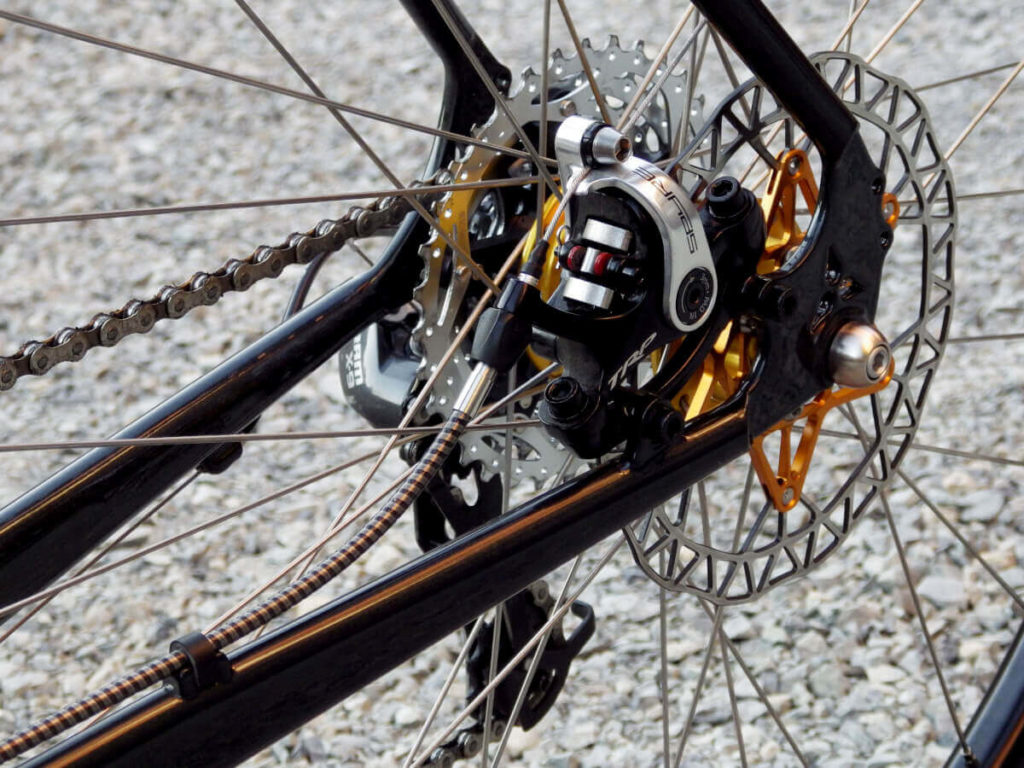

Rodriguez Bandito with hydraulic SRAM disc brake
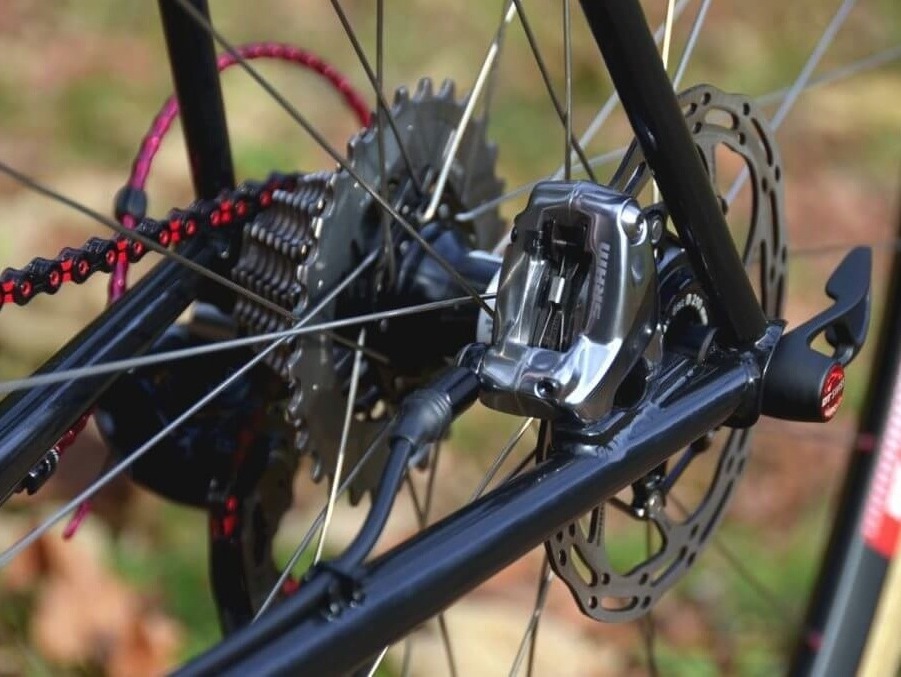

By now, you may be able to tell which one is the flat mount brake just by looking.....can you?
Conclusion
What this all boils down to is this: There is no performance difference between a 'flat mount' disc brake, and a 'post mount' disc brake. They are the same brake with the bolts in a different place. Flat mount will cost you more money, especially on a custom build. Depending on the build, you may be able to save a little weight one way or the other, but a flat mount brake by itself is NOT lighter than a post mount brake.
A Rodriguez Bandito frame is lighter than a Phinney Ridge frame because of the time consuming method in which we employ 'flat mount brakes' in order to save weight....make sense? You're paying more for extra labor to lighten the bike, not for better brakes. There are some other differences in the 2 bikes as well. If you'd like to read a quick comparison between the Phinney Ridge and the Bandito, here it is.
Phinney Ridge or Bandito...which one is for you?
There you go. That's a basic article on the 2 styles. I hope to help clear up any confusion you may have on the issue.
At Rodriguez Bicycles, we've been building bicycles with disc brakes since the 1970's. Very few manufacturers can make that claim. We've also written on the subject a few times. Although a bit dated, here's an article, Disco Fever, from 2012 that's kind of fun and informative about the long history of bicycle disc brakes.






